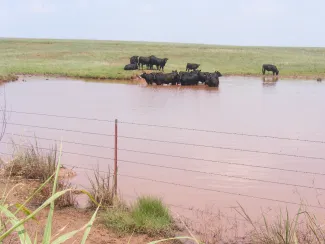You know what they say, location is everything. That is so true when it comes to building a pond. Besides making sure that the pond will collect and hold water, there are some other important items you need to consider to create a successful fishing pond. Addressing these issues up front will prevent headaches in the future. I highly recommend contacting your county NRCS office to perform a soil test to determine how much sand, loam and clay occurs in your pond bottom.
What is a muddy pond? Many ponds in Oklahoma will turn various shades of red, brown, or gray after a good rain. The big question is, does the pond clear up after a couple days or does it stay muddy for weeks, months or indefinitely? Likewise, with our numerous strong windy days, does your pond turn dingy?

A body of water is deemed turbid when small particles of organic matter are released into the water column by various processes and remain suspended, therefore staining the water. Materials such as leaf litter, grass particles, fish waste and other animal debris stay suspended temporarily but usually settle out. Minute soil particles such as clay can stay suspended for weeks to months. Depending on your local conditions, you could be in trouble. Some ponds will never clear up without intervention.
Why do you need a clear pond? Aquatic organisms living in a pond rely on sunlight to penetrate the water column in order to feed and grow. Microscopic plants and animals, or plankton, support larger organisms like aquatic insects and small fish which feed larger fish and so on all the way up the food chain. Sunlight generates this process which is called photosynthesis. A dingy, murky pond makes it very hard for any aquatic critters to thrive. A pond with a greenish tint shows that the sunlight is growing plankton and this type of pond is relatively healthy.
Agricultural activities such as grazing, tilling, planting, and harvesting near a water body disturbs the soil making it easy to wash in. A good buffer zone surrounding the pond will help keep adjacent soils from becoming disturbed and muddying up your pond. Allowing grasses or shrubs to grow next to the pond will help slow down runoff. You can also leave a strip or two of your crops to help catch loose soils from washing into the pond. Diverting cattle to another non-fishing pond helps as well.
Constructing the proper slope to the pond’s shoreline helps eliminate the mixing of the pond’s substrate. A shallow pond is just asking for trouble. Dig out at least a 3:1 slope, that’s 3 feet out for every 1 foot deep. Maintain an average depth of at least 4 feet for the whole pond. If left shallow, hot water in the summertime causes excessive algae growth and easy mixing of the pond bottom.
A simple yet effective test is available to determine if your pond will settle out on its own or if it needs chemical treatment to remove turbidity. It is called the jar test. Taking a quart sized jar, collect a full scoop of your pond water, screw the lid on and set aside so it’s not disturbed. Check it daily for a week or so to see if the clay particles sink to the bottom of the jar. If the jar clears up, you can follow the corrective measures below to help clean up your pond. If not, see treatment options #1 and #2 below.
Corrective Measures for Muddy Ponds
- Remove fish species that disturb the substrate such as common carp and bullhead catfish.
- Install hay bales or barley straw rolls along windward shoreline to catch wave action.
- Construct terraces around the pond to slow or catch sediment running off the watershed.
- Plant rye and fescue grass in bare areas to absorb runoff.
- Install rock jetties, tree falls and gravel berms to act as wind and wave breaks.
- During low water periods, use a track-hoe or bulldozer to deepen shallow spots.
- Plant aquatic vegetation species along the shoreline to slow erosion. Smartweed, arrowhead, bull tongue and pickerel weed are a few to try.
Treatment Option #1
- Apply gypsum (calcium sulfate) at 80 - 960 lbs. per acre ft (surface acreage ÷ the average pond depth).
- Best done during the fall and winter.
- Best applied with a trash pump and boat as a slurry. You can also mix it in the prop wash of an outboard motor.
Treatment Option #2
- If gypsum does not work, try applying aluminum sulfate at 13 – 52 lbs. per ac ft.
- Best applied with a trash pump and boat as a slurry.
- Be careful not to overdo with aluminum. If your pond water has low alkalinity (< 50 ppm), it can lower the pH of the water and harm aquatic life.